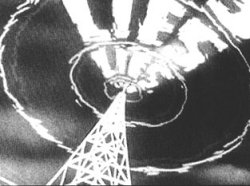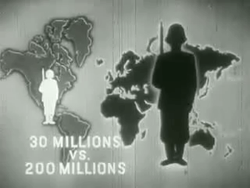World War II Documentary - Why We Fight - Ep. 1 - Prelude to War - Part 1
|
|
|
|
 (Picture:
Prelude to War depicts the Nazi propaganda machine)
(Picture:
Prelude to War depicts the Nazi propaganda machine)
Why We Fight is a series of seven propaganda films commissioned by the United States government during World War II to demonstrate to American soldiers the reason for U.S. involvement in the war. Later on they were also shown to the general U.S. public to persuade them to support American intervention.
Most of the films were directed by Frank Capra, who was daunted yet also impressed and challenged by Leni Riefenstahl's propaganda film Triumph of the Will and who worked in direct response to it. The series faced a tough challenge: convincing an only recently isolationist nation of the need to become involved in the war and ally with the Soviets, among other things. In many of the films, Capra and other directors spliced in Axis powers propaganda footage recontextualizing it so it promoted the cause of the Allies instead.
Why We Fight was edited primarily by William Hornbeck and is among the best examples of stock-footage montage ever produced, although some parts were re-enacted if there was no relevant footage available. The animated portions of the films were produced by the Disney studios with the animated maps following a convention of depicting Axis-occupied territory in black.
The films were narrated by Academy Award winning actor Walter Huston. This narration, though factual for the most part, is replete with nationalist and racist rhetoric describing implacably warlike Germans and "blood-crazed Japs." Conversely, it lionizes the courage and sacrifice of the British, Soviets, and Chinese. Realistic sound effects and soaring symphonic music complement the dramatic scenes.
At the end of each film, the quotation from Army Chief of Staff George Marshall that "...the victory of the democracies can only be complete with the utter defeat of the war machines of Germany and Japan." is shown on screen, followed by a ringing Liberty Bell over which is superimposed a large letter "V" zooming into the screen.
Made from 1942 to 1945, the seven films range from 40 to 76 minutes in length, and all are available on DVD or online.
Function as propaganda
 (Picture:
War Comes To America demonstrates America's hopeless position in the event of an Axis victory in Eurasia)
(Picture:
War Comes To America demonstrates America's hopeless position in the event of an Axis victory in Eurasia)
After World War I the methods used to gain support from troops and civilians needed to change. Therefore propagandists had to be more creative. Giving speeches to both soldier recruits and the American public was no longer effective. The soldiers correctly saw such direct and blatant propagandizing a big bore.[1] Film became the medium of choice to persuade the American soldier recruits that war is necessary.[1] As Kathleen German states, this was the first massive attempt to influence opinion in the U.S. military through film.[2] Film was also chosen because it combined the senses of sight and hearing, giving it an advantage over radio or print.[3] Capra, who had no experience in documentary films, was chosen because of his commitment to American ideals and because of the popularity of some of his earlier feature films. He was thought to understand the heart and soul of American audiences.[1] Once the documentary series was completed, it was said to contain the Capra touch.[4]
The series' appeal as propaganda was furthered by how the film was edited. Throughout his career Capra depended upon his skill as an editor to achieve the contrast of the individual and the group, critical in the success of his Hollywood movies.[5] Capra thought it would be most effective to use the enemy's original film and propaganda in the series in order to expose the enemies with their own images. By taking pieces of the enemy material to edit together and placing his own narration over the results, Capra gave meaning and purpose to the war through his created narrative.[6] This parallel editing[7] created an us vs. them image by reframing and showing clips out of their original order and context. The film compared and contrasted the forces of evil with America and its traditional values. Capra highlighted the differences between America and the enemy and showed how the enemy would attack these values if we did not fight.[8] This worked to create a battle not only between good and evil, but between the Allies and the Axis Powers.
As it turned out, the Why We Fight series became a heavily used means of propaganda for the American government during World War II. General Surles, the director of the Department of War's Bureau of Public Relations, had hoped that the series would be effective enough to allow any kind of army propaganda films to be shown to the general public.[9] Surles saw this goal realized when Prelude to War, the most successful of the seven films, was shown to President Franklin D. Roosevelt. Roosevelt saw this film as so important that he ordered it to be distributed in civilian arenas for public viewing.[6] However, some objections were raised against the Why We Fight series because it was so persuasive. Lowell Mellett, the coordinator of government films and aide to Roosevelt, saw the films as dangerous. He was most concerned with the effect the series would have after the war was over and the hysteria the films would create in their wake.[9] At least 54 million Americans had seen the series by the end of the war, and studies were done to gauge the impact of the films. However, the results were inconclusive, and therefore the effectiveness of the series is still in question.[10]
Episodes
1. Prelude to War (1942) (51:35) (Academy award as Documentary Feature) - this examines the difference between democratic and fascist states, and covers the Japanese conquest of Manchuria and the Italian conquest of Ethiopia. [1]
2. The Nazis Strike (1942) (40:20) - covers Nazi geopolitics and the conquest of Austria, Czechoslovakia and Poland. [2]
3. Divide and Conquer (1943) (56:00) [3] - about the campaign in Benelux and the Fall of France
4. The Battle of Britain (1943) (51:30) [4] - depicts Britain's victory against the Luftwaffe
5. The Battle of Russia (1943) (76:07) part 1, part 2 - shows a history of Russian defense and Russia's battle against Germany
6. The Battle of China (1944) (62:16) [5] - shows Japanese aggression such as the Nanking Massacre and Chinese efforts such as the construction of the Burma Road and the Battle of Changsha
7. War Comes to America (1945) (64:20) [6] - shows how the pattern of Axis aggression turned the American people against isolationism.
Prelude to War and The Battle of China refer several times to the Tanaka Memorial, portraying it as "Japan's Mein Kampf" to raise American morale for a protracted war against Japan. The authenticity of this document remains a topic of historical debate.
In 2000 the United States Library of Congress deemed the films "culturally significant" and selected them for preservation in the National Film Registry. Created by the U.S. Army Pictorial Services, the films are in the public domain; all of them are available for download at the Internet Archive.
References
Notes
1. a b c Combs and Combs, 1994, p. 69.
2. German, 1990, p. 237.
3. German, 1990, p. 238.
4. Koppes and Black, 1987, p. 76.
5. German, 1990, p. 240.
6. a b Combs and Combs, 1994, p. 70.
7. German, 1990, p. 241.
8. German, 1990.
9. a b Koppes and Black, 1987, p. 122.
10. Rollins, 1996, p. 81.
Tags: world war ii documentary, world war two documentary, film documentary, documentary films, documentary dvd, documentary world war 2, world war 2 movie, world war 2 video, world war 2 dvd, world war ii dvd, world war ii video, world war ii films, world war 2 dvds, world war 2 documentaries, world war ii documentaries, world war two films
Living Warbirds: The best warbirds DVD series.
Source: WikiPedia